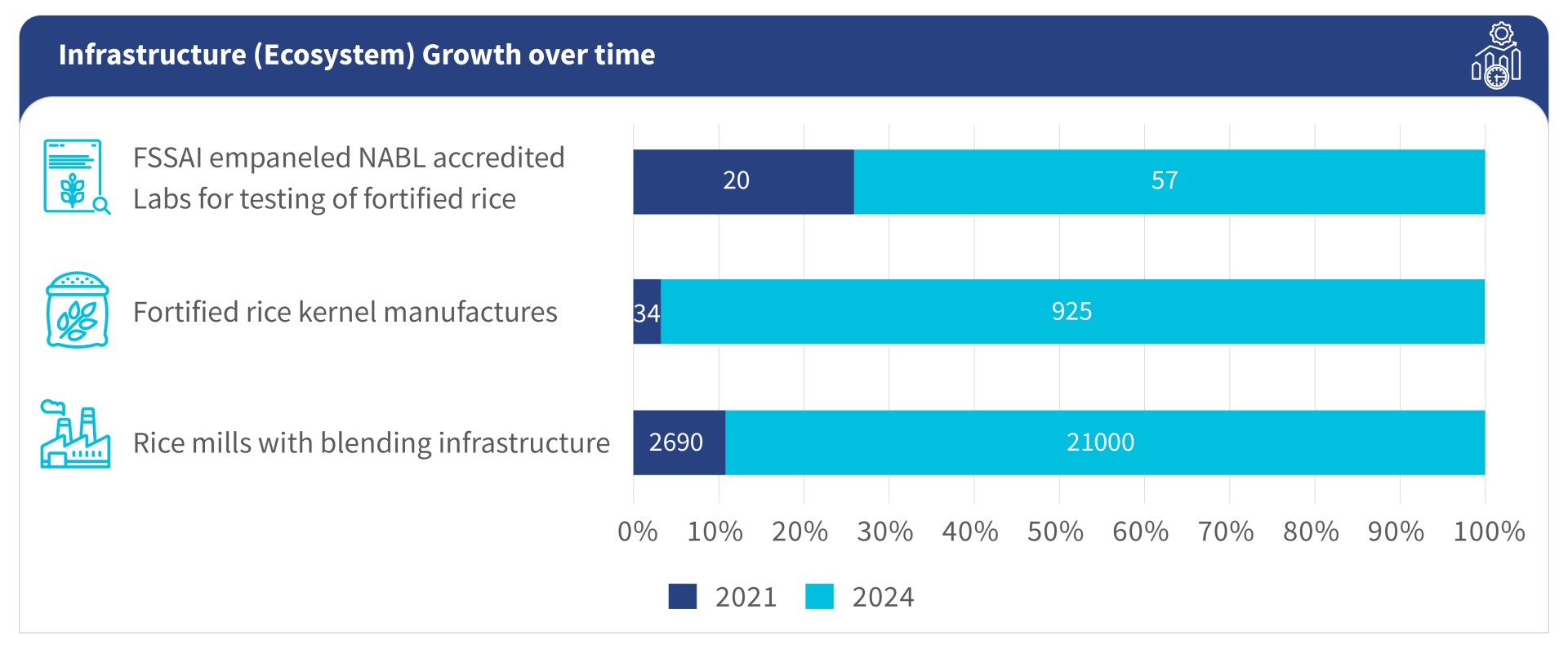From food security towards nutrition security – The crucial role of the rice fortification initiative of the Government of India
 by Manmohan Singh, Dipanshi Sood and Dr. Puneet Khanduja
by Manmohan Singh, Dipanshi Sood and Dr. Puneet Khanduja Mar 27, 2025
Mar 27, 2025 5 min
5 min
This blog explores how India’s rice fortification initiative tackles micronutrient deficiencies, particularly anemia, through the integration of fortified rice into social safety net programs and public-private collaboration. The initiative also paves the way for nationwide nutrition security. Read on to learn more.
India is at a pivotal moment in its journey towards achieving comprehensive food and nutrition security, particularly through the innovative initiative of rice fortification led by the Government of India. As we face the challenge of malnutrition and micro-nutrient deficiencies, the government has taken significant strides to ensure that our population has access to nutritious food that meets their dietary needs.
The Importance of Food Security
Historically, India has transformed from a nation reliant on food imports to one of the world’s largest agricultural producers. With self-sufficiency in food grain production, India now ranks among the top producers of various crops, including rice, a staple for approximately 65% of our population. The Government of India procures rice, wheat, and millet from farmers for distribution through its social safety net programs. The National Food Security Act (NFSA) plays a crucial role in this transformation by providing subsidized or free food grains to over 813 million people, focusing mainly on vulnerable groups, including pregnant women, lactating mothers, and children under 14.
The Targeted Public Distribution System (TPDS) ensures no individual goes hungry. During the COVID-19 pandemic, initiatives like the Pradhan Mantri Garib Kalyan Anna Yojana (PMGKAY) demonstrated the government’s commitment to food security by providing additional free food grains to those in need. This initiative will continue for five years, starting January 2024, reflecting the government’s long-term vision for addressing national food and nutrition security. This long-term commitment reassures the public and stakeholders of the initiative’s sustainability and dedication to the cause, instilling a sense of security and confidence in the initiative’s future.
Transitioning Towards Nutrition Security
While achieving food security is essential, it is equally vital to transition towards nutrition security. Anemia remains a significant public health concern in India, affecting maternal and child health and national productivity. In response, the government launched the Anemia Mukt Bharat (AMB) initiative in 2018, which includes mandatory provisions for fortified foods in public health programs.
Fortification involves intentionally boosting the levels of key micronutrients—such as vitamins and minerals—in food or condiments. Not only does fortification increase the nutritional value of staple foods, but it also helps to replenish micronutrients that may be lost during food processing.
The government initiated a rice fortification pilot program in 2019, recognizing rice as a staple millions consume. In 2021, on the occasion of Independence Day, Hon’ble PM Sh. Narendra Modi announced that fortified rice will be provided across all government social safety net schemes by 2024. The initiative was thus scaled in a phased manner, accounting for the rice fortification ecosystem and supply chain growth simultaneously to meet the requirements of central government schemes. This ambitious plan aims not only to enhance nutritional standards but also to combat anemia effectively.
Progress and Achievements
The rice fortification initiative has made significant strides, being implemented in phases after the pilot and expanding across various programs such as Integrated Child Development Services (ICDS), school feeding program (PM-POSHAN), and Targeted Public Distribution System. By March 2024, all non-fortified rice in these social safety net programs has been replaced with fortified rice. The program has been evaluated, and the findings have shown promising results, indicating reductions in the prevalence of anemia among children and women in study districts. Buoyed by the results and further need to work on micronutrient deficiencies, the Government of India has recently extended this initiative until December 2028 with a budget outlay of INR 17082 crores. The quantity of fortified rice distributed and the budget outlay of the initiative have increased multifold since the pilot, instilling optimism for the future of nutrition security in India.
Table 1: Giant leap in program implementation and commitment of the Government of India to the Rice Fortification Initiative

Implication for Private Sector: The Rice Fortification Ecosystem developed so far, and opportunities ahead
The rice fortification process involves enriching rice with Iron, folic acid, and Vitamin B12 by blending custom-milled rice with fortified rice kernels (FRK) 1% by weight. Similarly, fortified rice kernels are prepared by adding fortificants (Iron, folic acid, and Vitamin B12) premixes with rice flour and water, and FRK is made through the extrusion process.
The Government, working alongside key stakeholders and industry, has made significant strides in developing India’s rice fortification ecosystem. The infrastructure needed for manufacturing, blending, and ensuring the quality of fortified rice has grown robustly. The country has approximately 925 active fortified rice kernel manufacturers with over 111 lakh metric tons of production capacity annually. Approximately 232 new premix manufacturers have been established in the country. Additionally, around 21,000 operational rice mills are now equipped for blending fortified rice. The Food Safety and Standards Authority of India (FSSAI) has established testing protocols that ensure consistency across laboratories, enhancing the quality assurance process for fortified foods. As of February 2025, there are 57 FSSAI-empaneled NABL-accredited labs for fortified rice testing, 32 for testing Fortified rice kernel, and 13 for testing premixes in the country. The private sector’s active participation and contribution to the initiative are highly valued and integral to its success.

The initiative has been extended until December 2028, with increased yearly blending and a fortified rice kernel requirement. This extension provides policy consistency and a clear timeline for stakeholders to plan their participation in the initiative. It also demonstrates the government’s long-term commitment to the rice fortification initiative, encouraging stakeholders to continue supporting and participating. Moreover, the success of India’s rice fortification initiative has sparked renewed interest from other countries in the Global South, who are now looking to replicate this model in their nations. This opens the doors for the open market fortification of rice and exporting fortificants, Fortified rice kernels, and fortified rice.
Looking Ahead: The Way Forward
Monitoring and evaluating the rice fortification program, including quality aspects and its impact on public health outcomes, is paramount. The Government of India is conducting a time series repeat cross-sectional study to measure the impact of iron-fortified rice on iron deficiency anemia among the targeted consumers. Once available, the results will help refine strategies and ensure effective delivery.
Furthermore, successfully implementing rice fortification benefits the current situation and opens up possibilities for fortifying other staples such as lentils, millets, and other grains with essential micronutrients like iron, zinc, and folic acid. This promising prospect can significantly enhance the nutritional profile of our food supply, offering a brighter future for public health.
Additionally, integrating the provision of other nutritious commodities such as millet, fruits, vegetables, eggs, and milk into the public distribution system’s supply chain through initiatives like Jan Poshan Kendras and promoting sustainable agricultural practices can significantly enhance nutritional security and resilience against future food challenges. Engaging stakeholders at the State level, fair-price shop dealers, and communities about the benefits of fortified staples and a diverse diet can further bolster the program’s success.
Ultimately, a holistic approach that combines fortification with diversification and nutrition education will ensure that India’s population survives and thrives, equipped with the necessary knowledge for a healthy and productive life.
Conclusion
India’s rice fortification initiative marks a significant step towards addressing malnutrition and anemia by integrating fortified rice into social safety net programs. With substantial progress in infrastructure and promising initial results, the initiative is set to enhance nutritional standards nationwide in the medium to long term. Continuous monitoring and the inclusion of other nutritious commodities will further bolster nutritional security and resilience against future food challenges.
This article was first published on the NuFFooDS Spectrum platform on 6th March 2025.



Leave comments